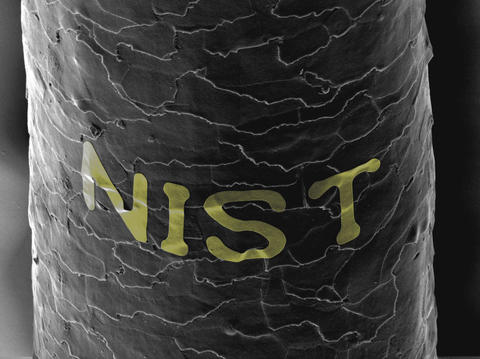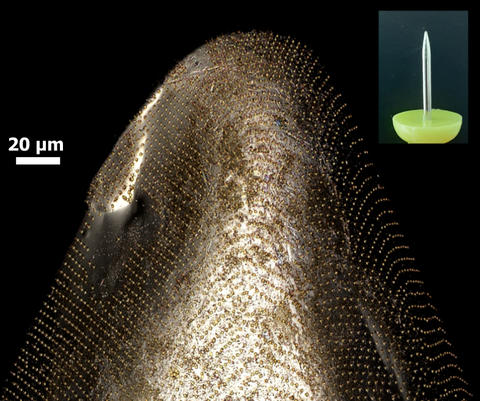Gary Zabow, researcher, transferred “NIST” onto human hairs using sugar and corn syrup (i.e. candy). This image is in grayscale microscopy.
Credit: G. Zabow/NIST
Gary Zabow, NIST scientist, never intended to use candy within his lab. It was only as a last resort that he had even tried burying microscopic magnetic dots in hardened chunks of sugar — hard candy, basically — and sending these sweet packages to colleagues in a biomedical lab. The sugar dissolves in water and the magnetic dots are free to study without any chemicals or harmful plastics.
By chance, Zabow had left one of these sugar pieces, embedded with arrays of micromagnetic dots, in a beaker, and it did what sugar does with time and heat — it melted, coating the bottom of the beaker in a gooey mess.
“No problem,” he thought. He would dissolve the sugar as usual. The microdots disappeared when he washed the beaker. But they weren’t really missing; instead of releasing into the water, they had been transferred onto the bottom of the glass where they were casting a rainbow reflection.
“It was those rainbow colors that really surprised me,” Zabow recalls. The colors suggested that the microdots remained in their original pattern.
The sweet mess inspired him to come up with an idea. Can regular table sugar be used as a way to extend the power of microchips on new and unusual surfaces? Zabow’s findings on this potential transfer printing process were published in Science In its November 25 issue.
Microprinting is the process of printing precise, but tiny patterns a few meter wide on surfaces to give them new properties. It’s used in electronics, semiconductor chips, and micropatterned surfaces. These tiny mazes of metals, and other materials were traditionally printed on silicon wafers. These intricate patterns, which are small and delicate, need to be printed on non-flat surfaces as more semiconductor chips and smart materials become available.
It is difficult to direct print these patterns on such surfaces. Scientists transfer prints. Although flexible tapes or plastics are possible (e.g. using putty for newsprint pickup), these solids might have problems conforming to sharp corners and curves once the print has been laid back. You might also find other chemicals or plastic residues that can be difficult to remove or unsafe for biomedical purposes.

REFLEX was used to transfer 1-micron disk arrays onto pin point.
Credit:
G. Zabow/NIST
You can also use liquid techniques. The transfer material is laid on the water surface and the target surface is pushed through the fluid. It can be difficult to place the print on a new surface if the fluid is not flowing properly.
To Zabow’s surprise, however, simple combinations of caramelized sugar or corn syrup can work.
This sugar mixture can be mixed with a little water and poured on micropatterns placed on a flat surface. After the water has evaporated, the candy will harden and can be removed with the pattern still embedded. The candy with the printed pattern is placed on top of the new surface, and then melted. As it melts, the sugar/corn syrup mixture retains its high viscosity. This allows the pattern to maintain its arrangement while it flows around curves and edges. You can wash the sugar with water and leave the pattern.
This technique, known as REFLEX (REflow–driven FLExibleXfer), allows microcircuit designs to be transferred to form a stencil. Scientists or manufacturers can then etch the desired materials and fill them in the correct places using this technique. For potential biomedical and microrobotics research, the patterned materials can be transferred to fibers or microbeads, or onto sharp or curved surfaces in new devices.
The technique proved successful for a large range of surfaces, including printing onto the sharp point of a pin, and writing the word “NIST” in microscale gold lettering onto a single strand of human hair. In another example, 1-micrometer-diameter magnetic disks were successfully transferred onto a floss fiber of a milkweed seed. The magnetically printed fiber reacts to the magnet and shows that the transfer was successful.
There’s still more to explore with REFLEX, but this process could open new possibilities for new materials and microstructures across fields from electronics to optics to biomedical engineering.
“The semiconductor industry has spent billions of dollars perfecting the printing techniques to create chips we rely on,” Zabow says. “Wouldn’t it be nice if we could leverage some of those technologies, expanding the reach of those prints with something as simple and inexpensive as a piece of candy?”
Paper: G. Zabow. Reflow transfer to conformal microprinting in three dimensions. Science. Published online November 24, 2022. DOI: 10.1126/science.add7023